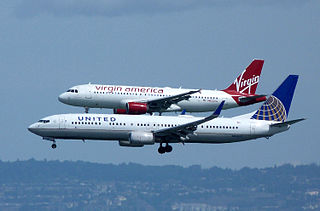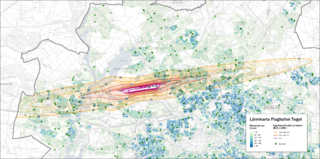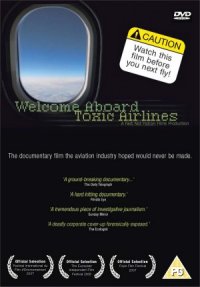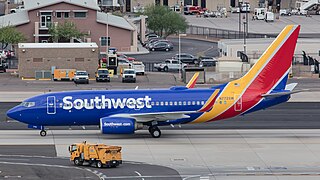
An airliner is a type of aircraft for transporting passengers and air cargo. Such aircraft are most often operated by airlines. Although the definition of an airliner can vary from country to country, an airliner is typically defined as an airplane intended for carrying multiple passengers or cargo in commercial service. The largest of them are wide-body jets which are also called twin-aisle because they generally have two separate aisles running from the front to the back of the passenger cabin. These are usually used for long-haul flights between airline hubs and major cities. A smaller, more common class of airliners is the narrow-body or single-aisle. These are generally used for short to medium-distance flights with fewer passengers than their wide-body counterparts.

An aviation accident is defined by the Convention on International Civil Aviation Annex 13 as an occurrence associated with the operation of an aircraft, which takes place from the time any person boards the aircraft with the intention of flight until all such persons have disembarked, and in which (a) a person is fatally or seriously injured, (b) the aircraft sustains significant damage or structural failure, or (c) the aircraft goes missing or becomes completely inaccessible. Annex 13 defines an aviation incident as an occurrence, other than an accident, associated with the operation of an aircraft that affects or could affect the safety of operation.

A flight attendant, traditionally known as a steward or stewardess ; or air host or hostess, is a member of the aircrew aboard commercial flights, many business jets and some government aircraft. Collectively called cabin crew, flight attendants are primarily responsible for passenger safety and comfort.

Aircraft noise pollution refers to noise produced by aircraft in flight that has been associated with several negative stress-mediated health effects, from sleep disorders to cardiovascular ones. Governments have enacted extensive controls that apply to aircraft designers, manufacturers, and operators, resulting in improved procedures and cuts in pollution.

The British Aerospace 146 is a short-haul and regional airliner that was manufactured in the United Kingdom by British Aerospace, later part of BAE Systems. Production ran from 1983 until 2001. Avro International Aerospace manufactured an improved version known as the Avro RJ. Production for the Avro RJ version began in 1992. Later on, a further-improved version with new engines, the Avro RJX, was announced in 1997, but only two prototypes and one production aircraft were built before production ceased in 2001. With 387 aircraft produced, the Avro RJ/BAe 146 is the most successful British civil jet airliner program.

Aviation safety is the study and practice of managing risks in aviation. This includes preventing aviation accidents and incidents through research, educating air travel personnel, passengers and the general public, as well as the design of aircraft and aviation infrastructure. The aviation industry is subject to significant regulation and oversight.

The British Airline Pilots’ Association (BALPA) is the professional association and registered trade union for UK pilots. BALPA represents the views and interests of pilots, campaigning on contractual, legal and health issues affecting its members and the flying public.
Bleed air is compressed air taken from the compressor stage of a gas turbine, upstream of its fuel-burning sections. Automatic air supply and cabin pressure controller (ASCPC) valves bleed air from low or high stage engine compressor sections; low stage air is used during high power setting operation, and high stage air is used during descent and other low power setting operations. Bleed air from that system can be utilized for internal cooling of the engine, cross-starting another engine, engine and airframe anti-icing, cabin pressurization, pneumatic actuators, air-driven motors, pressurizing the hydraulic reservoir, and waste and water storage tanks. Some engine maintenance manuals refer to such systems as "customer bleed air".
Air rage is aggressive or violent behavior on the part of passengers and crew of aircraft, especially during flight. Air rage generally covers both behavior of a passenger or crew member that is likely caused by physiological or psychological stresses associated with air travel, and when a passenger or crew member becomes unruly, angry, or violent on an aircraft during a flight. Excessive consumption of alcohol is often a cause.

The Beechcraft 1900 is a twin-engine turboprop regional airliner manufactured by Beechcraft. It is also used as a freight aircraft and corporate transport, and by several governmental and military organizations. With customers favoring larger regional jets, Raytheon ended production in October 2002.
Patricia A. Friend is the former International President of the Association of Flight Attendants-CWA, AFL-CIO. A United Airlines flight attendant since 1966, during her 16 years as International President, Friend was a respected leader in the airline industry and throughout the labor movement.

Welcome Aboard Toxic Airlines is a 2007 British documentary film about aerotoxic syndrome directed and produced by former airline captain Tristan Loraine.
The Aerotoxic Association was founded on 18 June 2007, at the British Houses of Parliament by former BAe 146 Training Captain John Hoyte, to raise public awareness about the ill health allegedly caused after exposure to airliner cabin air that he claimed been contaminated to toxic levels, by engine oil leaking into the bleed air system, which pressurizes all jet aircraft, with the exception of the Boeing 787.
Aerotoxic syndrome relates to ill-health effects associated with breathing contaminated air in an airliner cabin. Researchers have associated aerotoxic syndrome with exposure to substances such as engine oil and hydraulic fluid. Although researchers have identified correlations between the aircraft occupational environment and symptoms of aerotoxic syndrome, this condition is not an established medical diagnosis because the incidence and aetiology of the condition are still under debate.

A fume event occurs when bleed air used for cabin pressurisation and air conditioning in a pressurised aircraft is contaminated by fluids such as engine oil, hydraulic fluid, anti-icing fluid, and other potentially hazardous chemicals.

The Douglas DC-2 is a 14-passenger, twin-engined airliner that was produced by the American company Douglas Aircraft Company starting in 1934. It competed with the Boeing 247. In 1935, Douglas produced a larger version called the DC-3, which became one of the most successful aircraft in history.
American Eagle is a US brand name for the regional branch of American Airlines, under which six individual regional airlines operate short- and medium-haul feeder flights. Three of these airlines, Envoy Air, Piedmont Airlines, and PSA Airlines, are wholly owned subsidiaries of the American Airlines Group. American Eagle's largest hub is Charlotte Douglas International's Concourse E, which operates over 340 flights per day, making it the largest express flight operation in the world.

A Dark Reflection is a 2015 British independent investigative thriller film directed and produced by former British Airways airline captain Tristan Loraine. Billed as Erin Brockovich meets All the President's Men and as a fact-based investigative thriller, the film is based on the director's own experience as a commercial pilot.

Southwest Airlines Flight 1380 was a Boeing 737-700 that experienced an uncontained engine failure in the left CFM56-7B engine after departing from New York–LaGuardia Airport en route to Dallas Love Field on April 17, 2018. The engine cowl was broken in the failure and cowl fragments damaged the fuselage, causing explosive depressurization of the aircraft after damaging a cabin window. Other fragments caused damage to the wing. The crew carried out an emergency descent and diverted to Philadelphia International Airport. One passenger was partially ejected from the aircraft and sustained fatal injuries, while eight other passengers sustained minor injuries. The aircraft was substantially damaged.












